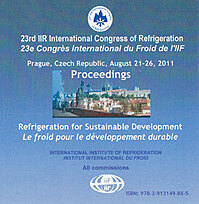
Document IIF
Transfert de chaleur et de masse dans une couche de baies pendant le processus de congélation.
Heat-mass transfer in layer of berries during the freezing process.
Numéro : pap. ID: 867
Auteurs : ABOLTINS A., BOCA S., GALOBURDA R., et al.
Résumé
Qualitative changes of berries during freezing have been investigated with instrumental methods. In order to economize energy it is proposed to determine the freezing temperature of products. The objective characterisation of physical properties of products enabled to evaluate quality, to incorporate it into the technological regimes of the treatment. Numerical results of process modelling are shown. The freezing regime is defined by several thermo-physical parameters of the production. Water stage turning into ice essentially affects the quality of the frozen product. In products ice crystal formation take place at a relatively low temperature. This susceptibility of sugar containing products to temperature fluctuations possibly is due to their high concentrations of unfrozen water and lower melting temperature. It is possible to calculate the mass fraction of ice depending on temperature and moisture content in product what is very important for predicting the product quality. Experimental investigation was carried out at Latvia State Institute of Fruit Growing.
Documents disponibles
Format PDF
Pages : 6 p.
Disponible
Prix public
20 €
Prix membre*
Gratuit
* meilleur tarif applicable selon le type d'adhésion (voir le détail des avantages des adhésions individuelles et collectives)
Détails
- Titre original : Heat-mass transfer in layer of berries during the freezing process.
- Identifiant de la fiche : 30001688
- Langues : Anglais
- Source : Proceedings of the 23rd IIR International Congress of Refrigeration: Prague, Czech Republic, August 21-26, 2011. Overarching theme: Refrigeration for Sustainable Development.
- Date d'édition : 21/08/2011
Liens
Voir d'autres communications du même compte rendu (569)
Voir le compte rendu de la conférence
Indexation
-
Numerical simulation and experimental investiga...
- Auteurs : GAO Y., SHAO S., ZOU H., et al.
- Date : 07/04/2016
- Langues : Anglais
- Source : 4th IIR International Conference on Sustainability and the Cold Chain. Proceedings: Auckland, New Zealand, April 7-9, 2016.
- Formats : PDF
Voir la fiche
-
A tool for predicting the quality of food produ...
- Auteurs : GWANPUA S. G., VERBOVEN P., HO Q. T., et al.
- Date : 21/08/2011
- Langues : Anglais
- Source : Proceedings of the 23rd IIR International Congress of Refrigeration: Prague, Czech Republic, August 21-26, 2011. Overarching theme: Refrigeration for Sustainable Development.
- Formats : PDF
Voir la fiche
-
Uticaj smrzavanja na kvalitet jagodastog voca.
- Auteurs : STEVANOVIC S., KOSI F., MARKOVIC D., et al.
- Date : 03/12/2014
- Langues : Serbe
- Source : Zbornik radova. 45. Medunarodnikongres i izložba o grejanju hladenju i klimatizaciji./ Proceedings. 45th International congress and exhibition on heating, refrigeration and air conditioning (HVAC&R).
- Formats : PDF
Voir la fiche
-
Quantitative comparison of thawing conditions.
- Auteurs : ILJINS U., SKRUPSKIS I., ABOLTINS A.
- Date : 19/09/1999
- Langues : Anglais
- Formats : PDF
Voir la fiche
-
Numerical investigation of heat and mass transp...
- Auteurs : KOCATÜRK S., EGRICAN A. N.
- Date : 23/06/2014
- Langues : Anglais
- Source : 3rd IIR International Conference on Sustainability and the Cold Chain. Proceedings: London, UK, June 23-25, 2014
- Formats : PDF
Voir la fiche
